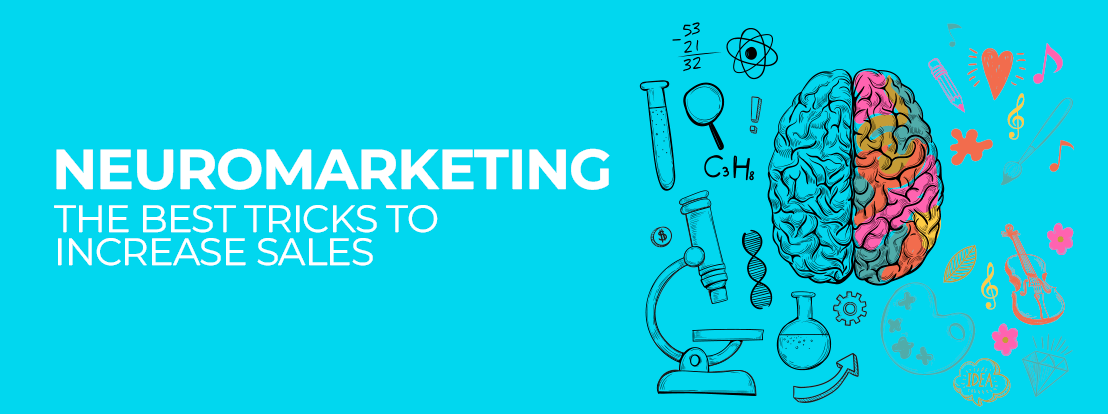Table of contents
- 1 Neuromarketing
- 2 What is not neuromarketing
- 3 Tricks that you can apply to your own ecommerce
- 3.1 Website usability
- 3.2 Do not abuse of disruptive or distracting advertising
- 3.3 Recommended products
- 3.4 Attention to design
- 3.5 To provoke love at first sight
- 3.6 Test the first impression that the website makes on the customer
- 3.7 Using the user’s imagination to convey sensations
- 3.8 Humanize and personalize automation
- 3.9 Create visual content
Neuromarketing
We have been immersed for more than a decade in an information society where everything is collected, analyzed and investigated with the intention of improving all kinds of processes. If, since the origins of civilization, human beings have conscientiously analyzed both the nature of their decisions and the influences we received from the outside, the advance of the years and technological development have only increased these natural tendencies. Right now, from our tastes to our actions, especially of a commercial nature, are recorded and analyzed in search of a better way to attract our attention, to improve our communicative messages, and to evolve in terms of design and usability.
Hence, for a few years now, there has been a discipline called neuromarketing, which is responsible for giving an empirical and scientific context to all this tangle of assumptions and attempts to influence the consumer. Let’s start from the fact that neuromarketing is a research discipline, not an exact science. Like all branches of psychology, its foundations lead to theories and hypotheses but not to absolute results, as are the scientific ones, since, when we talk about humans, constants do not exist. This method uses a series of methodologies aimed at detecting psychophysiological reactions, which manifest themselves at the cerebral level or in the nervous system in response to a specific stimulus. For this purpose, technologies such as electroencephalography (EEG), nuclear magnetic resonance (NMR) (specifically an evolution of the same called functional magnetic resonance, known as fMRI), positron emission tomography (PET), facial recognition, eye tracking or the detection of skin reactions (sweating, capillary muscle contraction), pupil study, blood pressure or heart rate, and a lot of other things that sound like a dialogue between characters from the TV series, The Big Bang Theory, are used.

The reality is that neuromarketing is still in its infancy. They are expensive, slow, costly (in time and money) techniques that only a handful of giant companies can afford on a large scale. In all cases they do not serve to “read” the mind directly and instantaneously, as if it were a backoffice where statistics could be consulted, but are simply useful to detect which areas of the brain are activated before a stimulus (whatever it is), what other bodily reactions are presented and thus try to deduce what emotions or moods arise in the subject observed before a stimulus related to marketing. Even so, there are consulting firms specialized in the subject, which are used by large companies to perform A/B tests or to choose between different design options based on the different reactions that each alternative arouses. And it is from there, from the results of these different studies throughout half the world by different companies of all types, where we can draw some conclusions that we could call “generic”, or at least, we can use to channel our business under neuromarketing premises. The idea is to try to identify behavioral patterns that can be used as marketing tools or to find explanations for existing patterns for which we do not have a reasonable explanation as to why they happen.
What is not neuromarketing
An important point of the matter, before we start listing the different actions you can try in your online store, is to try to discern what we are talking about. Keep in mind that in something as complex and new as this discipline is, it is easy to get confused with so much information and, finally, anything sounds like good science (without being so). In the universe of neuromarketing there is a lot of chaff. And, as in everything related to marketing, there are a lot of profiteers who try to sell their movies as neuromarketing. The most classic thing is to show you old school marketing tactics, old school marketing disciplines and techniques, to which now they add a couple of words related to neuromarketing, and they package it as “new”.
- Psychological pricing. The classic “don’t put 10, put 9.99 that seems less”. It is something so old that Coca-Cola seems new next to it, however, marketing “gurus” (if someone calls someone a “guru”, be suspicious, if someone calls himself a “guru”, run away) talk about it as if it were the result of neuromarketing studies.
- The placement of products on a shelf, the headers of the shelf or the layout of a store (this is visual merchandising all life) that supermarkets and stores have been using for over 100 years.
- The use of music, color, touch or smell to induce customers to buy faster or slower or to make them feel good or buy a certain product (El Corte Inglés has been doing it for 75 years, and I don’t think they scan every customer’s brain). This is called sensory marketing, and its field is psychology, not neuroscience.
- Generating impulse buying based on offers and promotions (yes…something super new. It’s older than coughing. There are people who pretend to help you design offers using “neuromarketing”, as if offers can be constructed based on neology precepts…Follow this advice: It’s a hoax.
- The use of psychology to design slogans or the use of photography to associate images of sexual content to products (the stunning girls/super muscular guys/famous people/football players, etc.). If you go to the Renaissance, you will see that they were already using it in the art of the time to illustrate religious precepts.
- If someone tells you that they know neuromarketing techniques to make a message go viral on the Internet, run away as if they were the witch from Snow White, because they are deceiving you with a bad intention that is worthy of being judged. There is no formula, either more or less successful, that defines a content as viral. There are minimum quality and content requirements for that to be possible, but in general, we cannot determine what will succeed virally and what will die in the oblivion of the network.

Well, we may not know exactly what neuromarketing is yet, but you certainly know what it is not. You have to keep in mind that today there are many professionals trying to sell training and knowledge as if it were a product, and that many of these “trainers” what they do is to embellish, decorate and expand concepts that more or less know to package and sell them as if they were the gold that led to Jesus Christ. And no, not everything goes, and of course, it is better to know little and use it well, than to try to know a lot and do it in a chaotic and meaningless way.
Tricks that you can apply to your own ecommerce
Now that it is clear that neuromarketing applied to sales is something typical of multinationals (and even so, it is also something very rare), and that, except in very specific cases and contexts, it is not used too much, we can now try to formulate a series of basic concepts that are really of practical use in our day to day with the online store.
Website usability
It is not necessary to plug a thousand sensors to a person to know that the easier it is to use the interfaces and the management of the web, the more likely to succeed in the number of conversions and customer loyalty. The human brain is lazy, and appreciates simple, clear, clean compositions, which are not strident or distort the areas of attention that are most needed. We speak of a natural design when the user does not have to think or search for navigation elements, but they simply appear intuitively.

Do not abuse of disruptive or distracting advertising
Because we will generate adverse emotional costs and rejection in the user. The same as we said before: cleanliness and specific areas that call to action. If you have dozens of call to actions in your Home page, which demand the user’s attention, probably what you will get is that they will ignore all of them, since there are so many points of attention that the user does not know where to place his attention and, unconsciously, he will ignore them all. We are not even talking about the classic pop-ups, warnings or notifications that, directly, annoy the user and it is not that we should not abuse them, it is that we should use them very carefully and very rarely.
Recommended products
if we put numerous services and/or products within the user’s reach, their decision-making process collapses and ends up causing them to make an indecisive purchase. The famous “recommended products”, “other users have also bought”, “related products” … are sections that work great and are proven to contribute to a natural and progressive navigation, which leads the customer to navigate through more sections of the store, which increases the chances of converting sales, but we must be careful with them, because if we abuse these, or put several sections of this kind, the customer will get lost in a kind of new catalog at the end of the product sheet. The purpose of these sections is to lead him, by a path of crumbs, to products that are likely to be purchased, given the decisions he has made so far. It is not a matter of putting everything you can on the customer, to see if he will “bite” at something. It’s a matter of aiming, not shooting a lot.
Attention to design
Again, we must pay special attention to the design of our online store. If we want the customer to correctly identify all the elements, and the composition to be clean and defined, we will have to use light backgrounds, mainly white and pale gray, using no more than three main colors (helped by shades and shadows derived from them, to expand the spectrum a little, but remembering that less is always more, at least as far as online design is concerned). We cannot forget the aesthetic fashions of the moment, and that a particular design trend tends to contribute to a correct navigation and a more pleasant feeling, since it is something recognizable. We cannot forget that users have already assimilated certain design patterns on specific topics, and that we cannot start innovating (it would be like changing the position of the driving elements of a car).
To provoke love at first sight
In the first visit, the first 50 seconds of visualization are the most important when a person enters a web page. In that time the user has more than enough time to get an idea of whether the site is worthwhile or a place to escape from.

Test the first impression that the website makes on the customer
To do this, tools such as Reelapp or ClickTale allow you to know the user’s behavior and opinion about the design of your website. It is difficult to do this without a Focus Group, or at least, users who have not been contaminated by the design process, who have remained outside it, and who are not included by the information provided by the members who have participated in the process. Sometimes it is not necessary to use technology, and simply by looking at the behavior of a user who has never had contact with the process of developing the online store, we can draw a number of conclusions that help us to modify and improve certain aspects of the design and usability of our ecommerce.
Using the user’s imagination to convey sensations
Just like your users, brands have a personality, and they try, by all means, to transmit it through their designs, their actions and their messages. Therefore, your goal should be to reinforce concepts already assimilated by your customers to use them to your advantage. We recently talked about the influence of color in the decision-making process in an online store. Resources such as color, shapes, typography, iconography… help us to reinforce this personality and transmit it coherently to the customer.
Humanize and personalize automation
Another clear objective in online marketing in general is to demonstrate that there is a person in front of the screen, not a machine or a program. The best way to demonstrate this is through an intelligent design in which it is very noticeable that the designer has taken into account the process that a user follows when buying. This humanizes the store, since it makes it clear that there is someone who is aware of our purchases, who tries to optimize the process to make it easier for us to do it.
Create visual content
the brain uses peripheral vision to retain an image in the subconscious, which increases brand retention in long-term memory. As Eye Traker studies show, we have a visual focus of attention, but the surrounding context does not disappear when we focus our attention, but contributes or disturbs the process. That is why it is important to take care of the design and, especially, the call to action that we want to integrate in it. If we intend to highlight a button on the background, it is important to use colors well, but above all, it is important to know how to locate the right place for that button, given the (more or less) generic patterns that users follow when browsing our website. We have to see the interface as a whole, not separating navigation elements from content elements. We must integrate everything as much as possible.
In conclusion, neuromarketing may come to represent the future of the profession and the entire discipline related to sales and advertising, since we tend to an empirical society where everything can be measured, quantified and classified, but, currently, it is still something reserved, almost exclusively, to big brands. Slow, expensive, highly technological processes that require large population samples to be reliable, leave both the application and research of neuromarketing in the background. We can conclude by saying that it is something that generates much more noise than has really been made clear, and that its practical applications, beyond usability design, are intermingled with classic marketing postulates, as well as psychology and psychologisms well known and studied by any marketing and advertising professional. As good as “neuromarketing” sounds, it is really a method from which we have been able to learn something but which, given its characteristics, is hardly applicable to the unique particularities of each business and commercial sector, so what we are left with are certain important postulates, from which we can learn, and we have no choice but to wait and see what the future brings us, which, let’s face it, seems to be getting closer and closer.
do you think we have anything left to say? Do you have more information on the subject that you want to share? Do you disagree with our conclusions and if you have successfully practiced neuromarketing in your online store? Well, don’t hesitate to comment or send us a message to our email.
greetings and good ecommerce!





Deja un comentario